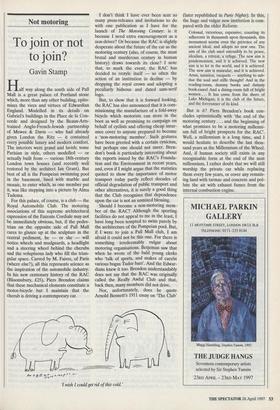Not motoring
To join or not to join?
Gavin Stamp
Half way along the south side of Pall Mall is a great palace of Portland stone which, more than any other building, epito- mises the vices and virtues of Edwardian England. Modelled in its details on Gabriel's buildings in the Place de la Con- corde and designed by the Beaux-Arts- trained Anglo-French-Jewish partnership of Mewes & Davis — who had already given London the Ritz — it contained every possible luxury and modern comfort. The interiors were grand and lavish; some Parisian in style, others modelled — or actually built from — various 18th-century London town houses (and recently well restored by the architect Ian Grant). But best of all is the Pompeian swimming pool in the basement, lined with marble and mosaic, to enter which, as one member put it, was like stepping into a picture by Alma Tadema.
For this palace, of course, is a club — the Royal Automobile Club. The motoring associations of this supreme architectural expression of the Entente Cordiale may not be immediately obvious, but, if the pedes- trian on the opposite side of Pall Mall cares to glance up at the sculpture in the central pediment, he — or she — will notice wheels and mudguards, a headlight and a steering wheel behind the cherubs and the voluptuous lady who fill the trian- gular space. Carved by M. Faivre, of Paris (where else?), all this represents science as the inspiration of the automobile industry. In his new centenary history of the RAC (Bloomsbury, £25), Piers Brendon claims that these mechanical elements constitute a motor-bicycle but I maintain that the cherub is driving a contemporary car.
I don't think I have ever been sent so many press-releases and invitations to do with one publication as I have for the launch of The Motoring Century: is it because I need extra encouragement as a non-driver? Or because the RAC is slightly desperate about the future of the car as the motoring century (also, of course, the most brutal and murderous century in human history) draws towards its close? I note that, to mark the event, the RAC has decided to restyle itself — so often the action of an institution in decline — by dropping the royal crown and adopting a peculiarly hideous and dated sans-serif logo.
But, to show that it is forward looking, the RAC has also announced that it is com- missioning the manufacture of a fold-away bicycle which motorists can store in the boot as well as promising to campaign on behalf of cyclists and offering cheap insur- ance cover to anyone prepared to become a 'non-motoring member'. Such gestures have been greeted with a certain cynicism, but perhaps one should not sneer. Bren- don's book is particularly interesting about the reports issued by the RAC's Founda- tion and the Environment in recent years, and, even if I might argue that the statistics quoted to show the importance of motor transport today partly reflect decades of official degradation of public transport and other alternatives, it is surely a good thing that the Club recognises that dependence upon the car is not an unmixed blessing.
Should I become a non-motoring mem- ber of the RAC? Although the sporting facilities do not appeal to me in the least, I have long been tempted to swim purely by the architecture of the Pompeian pool. But, if I were to join a Pall Mall club, I am afraid it could not be this one. For there is something irredeemably vulgar about motoring organisations. Betjeman saw that when he wrote of the bald young clerks who 'talk of sports, and makes of cars/in various bogus Tudor bars'. And the Edwar- dians knew it too. Brendon understandably does not say that the RAC was originally called the Really Awful Club and that, back then, many members did not drive.
Nor, unfortunately, does he quote Arnold Bennett's 1911 essay on The Club' 7 wish I could get rid of this cold.' (later republished in Paris Nights). In this, the huge and vulgar new institution is com- pared with the older Reform:
Colossal, victorious, expensive, counting its adherents in thousands upon thousands, this monument scorns even the pretence of any ancient ideal, and adopts no new one. The aim of the club used ostensibly to be peace, idealism, a retreat, a refuge. The new aim is pandemonium, and it is achieved. The new aim is to let in the world, and it is achieved. The new aim is muscular, and it is achieved. Arms, natation, racquets — anything to sub- due the soul and stifle thought! And in the reading-room, dummy books and dummy book-cases! And a dining-room full of bright women .. . It has come from the shore of Lake Michigan; it is the club of the future, and the forerunner of its kind.
But is it? Piers Brendon's book con- cludes optimistically with 'the end of the motoring century . . . and the beginning of what promises to be a motoring millenni- um full of bright prospects for the RAC'. Well, a millennium is a long time, and I would hesitate to describe the last thou- sand years as the Millennium of the Wheel. And, if human society still exists in any recognisable form at the end of the next millennium, I rather doubt that we will still worship the private car while replacing them every few years, or cover any remain- ing land with tarmac and concrete and pol- lute the air with exhaust fumes from the internal combustion engine.


































































 Previous page
Previous page